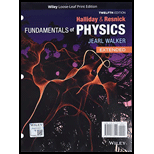
FUNDAMENTALS OF PHYSICS - EXTENDED
12th Edition
ISBN: 9781119773511
Author: Halliday
Publisher: WILEY
expand_more
expand_more
format_list_bulleted
Question
error_outline
This textbook solution is under construction.
Students have asked these similar questions
Problem 4: A particle moving along a straight path has an acceleration defined by a = 0.6s + 3.6 ft/s², where s is in feet.
If the particle's speed is 1.2 ft/s at s = 0, find its speed when s = 8 feet.
the rocket starts from rest at t=0 and travel straight up. it's height above the ground as a function of time can be approximated by s=bt^2+ct^3, where b and c are constants. at t=10s, the rocket's velocity and acceleration are v= 229m/s and a=28.2 m/s^2
A.) determine the time in seconds at which the rocket reaches supersonic speed (325 m/s)
B.) determine the value of constant B
C.) determine the value of constant C
The velocity of a particle is given by v = 20r - 100t + 50, where v is in meters per second and t is in
seconds. Plot the velocity v and acceleration a versus time for the first 6 seconds of motion and evaluate
the velocity when a is zero.
1.
Knowledge Booster
Similar questions
- A car moves 5m away from its initial position. Its displacement is 5m. Speed is a vector quantity with direction and magnitude. Instantaneous acceleration of a body is the time derivative of its velocity. true or false.arrow_forwardTwo runners start at the same point on a straight track. The first runs with a constant acceleration so that he could run 100 yards in 10 seconds. The second runner waits for 5 seconds and then throws a rock at his opponent's head. If the head is 5 feet from the ground and the rock starts 5 feet from the ground, what must be the initial velocity vector, |v0|, be if the rock is to meet the head just at the 100 yard tape? Report your answer in ft/s. Calculate tan(theta) and theta as well.arrow_forwardThe velocity of a particle which moves along the s axis is given by v = 5.6 -3.7t + 4t3/2, where t is in seconds and v is in meters per second. The particle is at the position s0 = 5 m when t = 0. Evaluate the acceleration (m/s2) when t = 7.5 s. Round off only on the final answer expressed in 3 decimal places.arrow_forward
- A hot-air balloonist, rising vertically with a constant velocity of magnitude 5.0 m/s, releases a sandbag at an instant when the balloon is 40.0 m above the ground. After it is released, the sandbag is in free fall. (a) compute the position and velocity of the sandbag 1.0 s after its release. (b) how many seconds after its release will the sandbag strike the ground?arrow_forwardAn object moving with uniform acceleration has a velocity of 15.0 m/s in the positive x-direction when its x-coordinate is 4.57 m. If its x-coordinate is – 7.13 m after 3.72 seconds, what is its acceleration?arrow_forwardIf a particle moving in a straight line with acceleration a = 5v m / s2 has a velocity v = 75 m / s at time t = 1 sec and s = 5 m, find the relations expressing the particle's velocity, acceleration and position as a function of time.arrow_forward
- A particle moving along a straight line is subjected to a deceleration a = (-2v^2) m/sec^2, where v is in m/sec. If it has a velocity v = 8 m/sec and a position s= 10 m when time t = 0, then determine its velocity and position when time t = 4 sec.arrow_forwardA toy car starts at rest and accelerates up A 40゚ ramp with acceleration a=(t3)1/2. It then flies into the air, and lands back on the ground. If the height of the ramp is h=6m, What is the horizontal distance X?arrow_forwardA particle’s position on the x axis is given by x = 4 - 27t + t3, with x in meters and t in seconds. (a) Because position x depends on time t, the particle must be moving. Find the particle’s velocity function v(t) and acceleration function a(t).arrow_forward
- The position of a particle moving along the x axis depends on the time according to the equation x = ct - btº, where x is in meters and t in seconds. Let c and b have numerical values 2.5 m/s4 and 1.2 m/s³, respectively. From t = 0.0 s tot = 2.5 s, Find its velocity at times (b) 1.O s, (c) 2.0 s, (d) 3.0 s, and (e) 4.0 s. Find its acceleration at (i) 4.0 s.arrow_forwardThe position of a squirrel running in a park is given by r⃗ =[(0.280m/s)t+(0.0360m/s2)t2]i^+ (0.0190m/s3)t3j^. At 5.64 s , what is the direction (in degrees counterclockwise from +x-axis) of the squirrel's velocity?arrow_forwardQ1/ A caris moves along a straight track with position given by s(t) = 150t - 300 ft (t in seconds). (a) Find v(t) and a(t). (b) find the displacement traveled over the interval [1, 4]. @2/ A particle moves in a straight line such that for a short time its velocity is defined by 9 = (t2 + t) m/s, where tis in seconds., When t =0, s =0. If t=3 sec find : 1- its position . 2-its acceleration . 3-its velocity .arrow_forward
arrow_back_ios
SEE MORE QUESTIONS
arrow_forward_ios
Recommended textbooks for you
 Principles of Physics: A Calculus-Based TextPhysicsISBN:9781133104261Author:Raymond A. Serway, John W. JewettPublisher:Cengage Learning
Principles of Physics: A Calculus-Based TextPhysicsISBN:9781133104261Author:Raymond A. Serway, John W. JewettPublisher:Cengage Learning

Principles of Physics: A Calculus-Based Text
Physics
ISBN:9781133104261
Author:Raymond A. Serway, John W. Jewett
Publisher:Cengage Learning